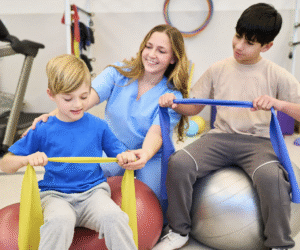When people think of Sensory Integration (SI) therapy, it’s easy to picture colorful swings, ball pits, textured toys, and climbing structures. And while these tools can certainly create a fun and engaging environment, true sensory integration therapy is not defined by equipment.
At its core, SI is a clinical, therapeutic approach that relies heavily on a therapist’s advanced understanding of the nervous system, sensory processing, motor development, and brain–body connection. The effectiveness of SI comes from the therapist — not the tools.
In this blog, we’ll explore why sensory integration is rooted in clinical skill, what high-quality SI treatment really looks like, and why choosing the right therapist matters far more than choosing the right gym setup.
What Is Sensory Integration?
Sensory Integration refers to the brain’s ability to take in information from the senses (touch, movement, sound, sight, body awareness, etc.) and organize it into meaningful responses.
Children and adults with sensory processing challenges often struggle with:
- Over-responsiveness (sensory sensitivities)
- Under-responsiveness (reduced awareness)
- Gravitational insecurity
- Difficulty with motor planning
- Poor postural control
- Emotional dysregulation
SI therapy aims to improve how the brain processes sensory input so that daily life – learning, playing, socializing, self-care – becomes easier and more regulated.
Why It’s Not About the Equipment
You can place a child on a swing, put them in a ball pit, or give them a fidget tool – but without clinical reasoning, these activities are simply play.
A sensory gym filled with expensive equipment does not guarantee sensory integration treatment.
The difference lies in the therapeutic intention, sequencing, and modulation behind every activity.
1. Equipment Doesn’t Create Change—The Nervous System Does
A platform swing does not automatically improve vestibular function.
A weighted ball doesn’t instantly increase proprioceptive input.
It’s all about how and why the therapist uses these tools.
A trained SI practitioner:
- Adjusts the speed, amplitude, direction, and duration of movement.
- Monitors autonomic signs to keep the child regulated.
- Chooses sensory inputs based on the child’s threshold, not on preference.
- Integrates cognitive, motor, and emotional goals into each task.
This requires advanced training, clinical reasoning, and moment-to-moment observation, not equipment.
2. Skilled Therapists Use Hands-On Techniques—Not Just Tools
True sensory integration therapy is deeply hands-on.
Therapists constantly provide:
- Graded tactile input
- Deep pressure and proprioceptive facilitation
- Guided movement
- Postural alignment support
- Motor planning prompts
- Modulated touch for calming or alerting
These techniques promote neuroplastic changes that equipment alone cannot achieve.
3. Proper Sensory Integration Requires Dynamic Adjustment
A sensory integration session is never static.
A therapist is constantly:
- Shifting demands based on regulation
- Adjusting stimuli
- Providing just-right challenge
- Monitoring arousal levels
- Ensuring safety
- Supporting adaptive responses
This real-time clinical decision-making is the heart of sensory integration — not the environment.
What Skilled Sensory Integration Therapists Really Do
A well-trained SI therapist focuses on how the nervous system responds, not what the child is doing.
They look at:
- Muscle tone
- Postural reactions
- Vestibular processing
- Joint stability
- Breath patterns
- Behavior cues
- Emotional regulation
- Adaptive responses
Then they tailor every activity—whether it involves swinging, crawling, climbing, or tactile play—to target the specific neurological pathways that need support.
The therapist’s ability to interpret sensory-motor behavior is what makes therapy effective, not the availability of a certain piece of equipment.
How to Know You’re Getting True Sensory Integration Therapy
Parents and caregivers can look for the following signs of high-quality SI intervention:
Therapist-Centered, Not Equipment-Centered
The therapist explains the “why” behind each activity clearly and ties the session to functional goals.
Adjustments Happen Frequently
You see the therapist modifying intensity, timing, or type of input based on the child’s behavior or body response.
Hands-On Facilitation
The therapist frequently provides physical guidance that supports stability, alignment, and sensory processing.
Regulation Is Prioritized
Sessions involve calming, organizing, and alerting techniques—not overstimulation.
The Child Produces Adaptive Responses
Meaningful progress is made in areas such as attention, motor skills, behavior, and emotional control.
Why Choosing the Right Therapist Matters Most
Sensory integration is a highly specialized therapeutic modality.
The therapist’s:
- Training
- Experience
- Ability to read a child’s responses
- Skill in modifying input
- Understanding of motor-sensory pathways
…determines the outcome far more than any swing or toy ever could.
Well-trained SI therapists understand neurobiology and can create meaningful change with minimal equipment when necessary. In fact, some of the most transformative techniques—deep pressure, joint compressions, guided movement, tactile play – require no specialized tools at all.
The Takeaway
Sensory integration therapy is an art, a science, and a clinical skill – not a room full of equipment.
At Crawl Walk Jump Run Therapy Clinic, our therapists are trained to use sensory-based approaches with intention, expertise, and evidence-based techniques that support real neurological change.
Because in the end: It’s not about the swing. It’s about the nervous system. And it’s the therapist who bridges that connection.




